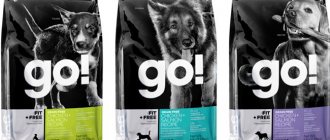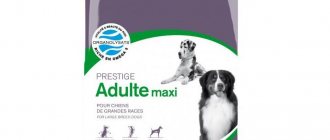Dogs quite often experience allergic reactions to food, certain foods, medications and even household chemicals. Under no circumstances should you ignore signs of allergies, since this directly affects your pet’s well-being . Specialists from the Berloga veterinary clinic in Moscow talk about how to recognize an allergic reaction in a dog and how to care for the animal.
Read in this article:
What is an allergy? Types of allergies in dogs What foods are dogs allergic to? How can you tell if your dog has an allergy? Diagnosis Treatment of food allergies in dogs Elimination diet First aid: what to do if a dog has allergies? Caring for a dog suffering from allergies How to protect a dog from allergies?
How does an allergy manifest itself?
Signs of a food allergy in dogs can vary widely, but most often they are:
- sneezing, coughing, sinus discharge;
- disturbance of the depth and rhythm of breathing, which can lead to the development of asthma;
- loose stools and vomiting. They can appear both together and separately;
- dizziness;
- otitis with damage to the soft tissues of the external meatus and auricle;
- lacrimation, purulent conjunctivitis.
The most common symptoms that accompany food allergies are itching and skin rashes all over the animal's body. If not treated promptly, the rash can lead to the formation of eczema and bleeding ulcers. In some cases, dogs may experience swelling in their limbs, face, digestive tract, and tongue. If left untreated for a long time, food allergies can destroy the immune system, and purulent conjunctivitis can lead to complete blindness.
External manifestations of allergies
How does dog allergies manifest externally? In terms of its characteristics, food has a lot in common with regular food. Its main external manifestations are rashes all over the pet’s body. In addition, various ear infections can develop, which over time become chronic. If you start giving your pet antibiotics, these manifestations temporarily disappear, but after a while they return again. Based on external manifestations alone, it is almost impossible to distinguish a food allergy from other possible reactions that may occur in the animal’s body.
Symptoms of the reaction
According to veterinary experts, the following clinical manifestations are observed with food allergies in dogs:
- Dermatological problems. The animal experiences skin redness, peeling, and in some cases a rash. The dog is constantly itching due to itching caused by the increased production of histamine-like substances. Dry skin leads to dandruff. With strong scratching, wounds, pustules, and weeping spots appear on the skin.
In severe cases, pyoderma may occur. The animal's fur is dull and tousled. A characteristic symptom of food allergy is patchy baldness. In the area of the sternum and armpits, some individuals experience an accumulation of allergic effusion.
- Otitis. An ear infection causes your pet to be constantly itchy and restless. The dog shakes its head and sleeps poorly. Exudate, which has an unpleasant odor, quickly accumulates in the ears. Allergic otitis media is practically not treated with antibacterial and anti-inflammatory drugs. After a slight improvement in the condition without eliminating the food allergen from the pet’s diet, a relapse occurs.
- In some cases, with a food allergy, a dog experiences lacrimation and suppuration in the corners of the eyes.
- Many owners note an unpleasant sweetish-sweet smell from the animal. Both the skin and the pet’s mouth can smell.
- In some individuals, the allergic reaction is accompanied by indigestion in the form of vomiting and diarrhea. Typically, a sick dog will defecate more often without changing the consistency of the stool.
- Swelling of the muzzle and limbs.
Veterinary nutritionists note that a non-standard reaction to food components can develop literally immediately when an allergen enters the body, or it can be a so-called delayed reaction. The appearance does not depend on the sex of the animal, whether the pet is neutered or not.
Many veterinary specialists note that allergies to food components are more often observed in miniature ornamental breeds, as well as in boxers, sharpeis, pugs, labradors and many high-pedigreed individuals.
Watch this video about the symptoms of food allergies in dogs:
Diagnosis of allergies
Identifying food allergies is quite simple, but it is important to understand that many diseases that dogs often suffer from are accompanied by similar symptoms, which, in turn, complicates the diagnosis. Therefore, before starting any treatment, you should try to find out if your pet is suffering from any diseases. For example, if a dog is itching and hair is falling out, it may be caused by scabies, fleas, overly sensitive skin, various intestinal parasites, bacterial infections and thrush.
Causes of food allergies
So, we already know how allergies manifest themselves in dogs, but what are the reasons behind it? As mentioned earlier, this is a response of the immune system to any substance or product that it considers pathogenic.
Most often, allergies are caused by animals eating the following foods:
- any meat;
- milk;
- fish;
- eggs;
- soy;
- wheat;
- corn.
All of these products are found in dog food sold in stores, so allergies are very common. This is due to the fact that plant and animal proteins, regardless of their different origins, have a similar structure. So, if you buy food for a dog with a protein allergy, your pet may get sick.
According to nutritionists, food allergies can be caused not only by intolerance to any ingredients, but also by using the same food over a long period of time.
Treatment of allergies in dogs
The dog owner begins treatment as follows:
- excludes proteins (meat) that are in the dog’s diet;
- offers another source of carbohydrates (grains).
The products must be different from those that the animal ate before the disease. The veterinarian will recommend a special hypoallergenic diet based on hydrolyzed proteins. These are substances that are already broken into small pieces, sufficient for the lymphoid tissue not to react to them.
As for drug treatment, you need to remember that allergies cannot be completely eliminated. But it can be treated, each time eliminating the symptoms that appear in response to the entry of a product with an allergen into the body. For this purpose:
- oral medications;
- injection therapy.
Did you know? More than 500 species of bacteria constantly live on a dog's skin.
Drugs
The medications prescribed depend on the symptoms a particular dog has and their severity. There are five main types of therapy.
| Type of therapy | Types of medications and features of use |
| Anti-inflammatory | Includes anti-inflammatory medications such as corticosteroids or antihistamines. Their task is to block the allergic reaction. Non-steroidal anti-inflammatory drugs for dogs:
|
| Immune modulators | Drugs that modify and reduce the dog's immune response to relieve itching. Main drugs:
|
| Food and dietary supplements | These are protein diets and Omega-3 acids. They help improve the patient's response to steroids and antihistamines. |
| Antipruritic | Represented by antihistamines, corticosteroids and Apoquel. Its dosage is 0.4–0.6 mg/kg 2 times a day for 7 days. This is a new medicine that is aimed directly at relieving itching by blocking the substances that provoke it. Corticosteroids:
Antihistamines:
|
| Shampoo therapy | Bathing not only removes possible plant allergens in the coat, but also soothes the skin, removes dead skin cells, and treats yeast infections and bacteria. Hypoallergenic shampoos: “Sinergy”, “EnimAl”, “Espri”, “Shampoo with calendula and honey Carly-Flamingo”, “Bifar”, “Wet Best”, etc. |
Each case of allergy is individual. Therefore, you need to not only get a doctor’s prescription, but also follow it. This will reduce the time spent on treatment, saving the dog from unnecessary suffering and possible complications due to prolonged exposure to an allergic reaction.
Diet
First of all, pay attention to a few important points. They relate to the characteristics of an allergic reaction to products:
- The bulk of commercial feed is presented according to the formula: chicken or beef + corn or wheat. Most dogs have never eaten lamb and rice, while this combination of foods is considered hypoallergenic. Therefore, this is an excellent solution for those who discover that their pet has allergies.
- You need to analyze the composition of the food that your dog regularly receives. Read the ingredients on the box. If you have figured out your “meat + grain” formula, now you need to buy a package in the store in which these 2 components are represented by other elements. For example, if your dog’s diet included chicken, then buy turkey, beef, lamb, etc. Until the symptoms disappear, the dog should only eat new food purchased by the owners.
Did you know? Scott Commins of the University of Virginia conducted a study in which he showed that tick bites can cause the immune system to produce antibodies to carbohydrates in beef, pork and lamb.
But it’s still not worth trying to treat your pet in this way
. While the dog is on any special diet, it is especially important that the diet does not include other foods: cookies, treats, cutlets and other products from your table. There is no need to provoke the development of allergies.
Once you are sure that your pet is not itching and there are no other symptoms after eating, you can gradually introduce other foods into the diet. Do this in small doses, offering no more than one new type of food every 2 days and be sure to monitor the body’s reaction.
Please note that in nutrition there are 3 types of food for dogs with food allergies:
- a diet with a limited number of ingredients - it is carried out until all the allergens that cause the reaction are identified;
- a diet with new ingredients is needed so that the body switches to a different combination of substances and the allergies become dull;
- a special diet for dogs undergoing treatment at the same time.
Skin and coat care
Medicines will relieve itching. To soothe irritated skin locally, you can wash your pet using anti-allergenic shampoo. This product should have moisturizing, anti-inflammatory and bactericidal properties.
Recommended to add to food:
- flaxseed oil (1/2 teaspoon per day);
- B vitamins (10–50 mg 2 times a day);
- spirulina (500 to 1000 mg 2 times a day with food).
Caring owners can offer a bath for their pet:
- Fill a container with warm water and let 3 herbal tea bags steep in it.
- Then wet and rinse the skin and coat for 5 minutes.
- As an alternative remedy, pour 2 cups of boiling water over 2 tea bags. Let cool and rub the itchy area.
Did you know? Chamomile, calendula and green tea have the ability to soothe and cool irritated skin. Therefore, they can be used in the form of compresses or rubs for itchy areas.
Apple cider vinegar is also a good skin disinfectant. It is diluted with water in a 1:1 ratio and used to wipe the inflamed areas. Remember that it should not be used on open wounds or areas damaged by scratching.
Many natural cosmetics now contain coconut oil. It has antibacterial and antifungal properties. Plus, it's an excellent moisturizer. This remedy can also be used for food allergies. The oil should be rubbed into the inflamed area.
Fighting allergies
If a dog is allergic to food, treatment is useless. The only solution to the problem in this case is an elimination diet.
- The first step is to switch the animal to feeding another food that you did not give before.
- Unusual food should be fed for at least three months. It is recommended to choose those types of food containing proteins and carbohydrates that the pet has not previously eaten.
- For example, if the food previously contained beef, you can try feeding dietary foods containing rabbit meat or venison. There are quite a lot of such feeds on sale.
What is the best food to feed a dog if the allergy does not go away over a long period of time? In this case, you can try types of food that use proteins and carbohydrates of such a small molecular size that they simply cannot cause allergies. You can also completely eliminate dry food from the animal’s diet and start giving home-cooked food.
If dogs are allergic to dry food, if you have several pets, then it is recommended to transfer all animals to a new diet. In this case, feeding should be done in separate rooms so that a dog with allergies does not have access to food from healthy individuals.
When eating, the pet should be locked in the next room. This is necessary so that the dog cannot pick up food dropped on the floor, since in this case he will have to start the diet all over again. If you have small children, be sure to wash their hands and face after eating.
Do not let your pet go outside alone, and during walks do not let him off the leash so that he is always under your supervision.
How to identify an allergenic product
The nonspecific nature of the clinical manifestations of food allergies requires a veterinary specialist to conduct a whole range of diagnostic studies. Similar symptoms may occur with infectious diseases, fungal infections, and helminthic infestations.
The doctor’s task is to carry out differential diagnostics - stool analysis for helminths, skin scrapings to detect trichophytosis, bacteriological cultures, serological blood tests.
In order to exclude a specific allergen product, a veterinarian draws up a so-called protein map and administers diagnostic nutrition for several months. First of all, poultry protein is excluded. It is to chicken that dog breeders most often observe allergies in their four-legged pets.
If within 10 - 12 weeks there is no improvement in the physiological state, then the following diet is prescribed, which excludes, for example, beef.
Due to the fact that cereals, in addition to animal proteins, can often cause an allergic reaction in dogs, wheat and corn are excluded from the diet. Rice is considered less allergenic. Holistic foods based on grain-free composition are often used as diagnostic food. Hydrolyzed products have split protein structures in the list of ingredients and cannot cause protein-type allergies.
An elimination diet allows, albeit slowly, but absolutely accurately, to identify the product that causes increased reactivity of the dog’s body. During the diagnostic diet, vitamin and mineral supplements, premixes, and treats are completely excluded from the pet’s diet. If after 10 - 12 weeks the dermatological and other symptoms disappear, then the cause of the allergy is the product excluded from the diet.
Skin tests to detect allergies in dogs
The final diagnosis is made after the so-called provocation. After the pet’s health returns to normal, the suspected provoking product is returned to its diet. And if in this case the clinical signs return, then the veterinarian makes a final diagnosis.
Feeding recommendations
A food allergy in dogs, the symptoms of which we already know, never completely goes away, but with the right diet, its manifestations can be completely eliminated. The first thing you should do is stop feeding your pet the usual foods, after which you can start creating a new menu. For example, if your dog's allergic reaction was caused by eating rice, then you should stop giving him anything other than rice. But also any other products that contain this ingredient.
When choosing a new diet, you should try to make it as balanced as possible. It is better to feed with those products that are similar in nutritional value to the previous food. If you do not adhere to this advice, then a lack of any substance can cause exhaustion, which, in turn, will only worsen the situation.
Allergenic products
Veterinary specialists, based on many years of observations, reasonably believe that a failure of the normal immune response to a foreign substance occurs in food proteins. It is the protein structures that make up food that most often cause a pathological reaction in the animal’s body.
In the first place, according to experienced breeders, are such products as poultry (chicken), beef, horse meat, and lamb. Recently, veterinary specialists have noted increasing cases of negative reactions from the animal body to meat products due to the presence of hormonal substances and preservative components in them.
In many pets, an immediate allergic reaction is caused by chicken eggs and some dairy products (fat cottage cheese, cheese, yoghurts with fillings). In some cases, the body reacts negatively to the presence of grain crops in the diet due to the presence of gluten and gluten in them - corn, wheat, barley, rye, soy and products based on it.
There are frequent cases of food allergies caused by a pet eating red-fleshed vegetables and fruits (tomatoes, red peppers, plums, etc.).
Undoubted allergens are foods such as chocolate, refined sugar, honey, smoked and pickled foods, pickles, butter, fried and fatty foods. Veterinary specialists categorically prohibit giving these components even to healthy pets. Your dog should use food additives based on brewer's yeast and complexes containing B vitamins with caution.
We recommend reading about shock in dogs. You will learn about the causes of anaphylactic shock in dogs, the first symptoms, and first aid measures for your pet.
And here is more information about why a dog smells.
What foods are best to include in your diet?
What is the best food to feed a dog with food allergies?
This question interests many people who have a dog at home. Nutritionists argue that it is not so much the products themselves that are important, but the principle of feeding the animal. It is based on feeding foods that the pet has either never tried before or has not consumed for a long time. When preparing food for your dog, you should only use one type of meat and grain. This feeding method will allow you to determine which substance caused the allergic reaction if you introduce one new ingredient into the diet every two weeks.
What foods should not be given?
If you have a food allergy in dogs, you should avoid feeding your pet certain foods that could be potentially dangerous.
These include:
- sea fish;
- rabbit, turkey and beef;
- today's fermented milk products;
- buckwheat, oat and rice cereals;
- pears, apples, carrots, zucchini.
Feeding with special types of food that have a therapeutic effect is allowed, but they should be selected together with a nutritionist. The specialist will perform a sensitivity test, after which he will be able to select the food that is best suited for your dog. But you should not overuse these foods, since their composition is very poor and they cannot provide the animal with the necessary amount of nutrients. In case of food allergies in dogs, it is very important not only to exclude the allergen from the diet, but also to create a good diet for the animal, which can be fed to the dog on an ongoing basis.
Together with dietary nutrition, the veterinarian can prescribe symptomatic medications that are aimed at reducing histamine levels in the body, relieving inflammatory processes, and also alleviating the clinical manifestations of food allergies in dogs. If the condition is too advanced, a course of immunomodulatory drugs may be necessary. But no medications can ever completely and permanently rid an animal of an allergic reaction without a special diet. At the same time, do not forget that pampering your pet is not the best solution, since even a small piece of a treat containing an allergen can completely negate all your efforts.
Causes of allergies to dry food
Owners often complain that when feeding ready-made industrial food, their furry pets experience clinical manifestations of allergies. The specific reaction of the body to dry food is explained by veterinary specialists by the widespread use of dyes, aromatic substances and flavor enhancers in their production.
Industrial feeds have a long shelf life, which is achieved by adding stabilizers and preservatives.
It is these ingredients that enhance the body’s negative reaction to the action of biological allergens and are often themselves the cause of a pronounced allergic reaction in the animal.
Inexpensive mass-market foods tend to have a high content of components uncharacteristic for the canine body. Manufacturers of premium and super-premium products minimize the presence of dyes and preservatives in the mixture.
However, dogs can often develop allergies to high-quality food. This is due to the fact that they contain corn, soybeans, and wheat. In some cases, allergies are caused not by one ingredient, but by a combination of allergens.
For how long should a therapeutic diet be followed?
If you have a dog food allergy, it is very important to choose the right diet.
But how long should you stick to it? Doctors advise following a diet for at least three weeks, but, as practice shows, it is not uncommon for an allergic reaction to a product to become apparent after a longer period of time. In most cases, in four-legged friends, an allergy to a new product introduced into the animal’s daily diet appears approximately 12 weeks after the start of feeding. Therefore, you should follow the diet throughout this entire period. If the manifestations of allergies begin to gradually decrease or disappear altogether, then it will be possible to return the pet to a normal feeding regimen using the same products. This is necessary in order to make sure that the animal has an intolerance to any product that provokes the development of allergies.
If a dog's food allergy occurs again, a veterinarian can accurately diagnose the problem and begin treatment. If there is no repeated confirmation of an allergy, but if there is a strong suspicion of it, you can try feeding your pet a different type of food.
Useful video
About the causes of food allergies and the Hills dry food diet, watch this video:
Similar articles
- Why does the dog smell (strongly like dog, fish, mice...)
Even the most expensive and high-quality food is not a guarantee that the dog is not allergic to the components of the mixture. The most common allergic reaction is to chicken. Read more - Dog nutrition: creating a diet and regimen if...
In the absence of an allergic reaction, chicken eggs can be used in feeding the dog. ... And here is more information about gastritis in dogs. The natural type of nutrition also includes carbohydrate foods. Read more
- Pyoderma in dogs: types - superficial, deep...
All Obstetrics in dogs Internal diseases in dogs Infections and parasites Care and education Surgical diseases and injuries. ... Allergic reactions. The animal is allergic to pollen, dust, household chemicals, food components... Read more
- Rhinitis in dogs and cats: symptoms and treatment
What is rhinitis in dogs and cats? Symptoms of rhinitis, its stages and forms. On what basis is the diagnosis made? … primary (whether the disease is caused by allergies, mechanical damage, severe hypothermia or parasites)… Read more
- Runny nose in a dog: causes in small breeds, how to cure...
Causes of runny nose in dogs, incl. in small breeds. Inflammation of the nasal cavity in animals can be a .serp-item__passage{color:#888}... Allergic reaction. The cause of a pet's nasal discharge may be an allergy to food, household chemicals... Read more
Making a diagnosis using laboratory tests
Today in medical practice there is no research method that could establish with one hundred percent probability that a dog has a food allergy.
The most commonly used test is a blood test, but it is ineffective. As for intradermal tests, which are used to diagnose common allergies, in the case of food allergies they do not give any results at all. Therefore, the only way out in this situation is to use the elimination diet, which was described earlier in this article.
"False" allergy
An allergic reaction occurs due to an increase in the level of histamine in the animal’s body. This substance is produced by the immune system in response to the appearance of an allergen in the body. But there are cases when histamine is not produced by the immune system, but enters the body along with some food product. All this leads to the development of a so-called “false” food allergy in dogs, which in its manifestations is very similar to a food allergy.
The whole problem is that the use of special medicinal feeds and changing the diet are ineffective, since not one, but all foods that contain large amounts of histamine and tyramine will have to be removed from the diet. After this, the veterinarian will have to calculate the acceptable level of these substances at which the dog will not develop an allergic reaction. In addition, a special diet will have to be drawn up, consisting of foods containing histamine and tyramine. The purpose of this diet is to accustom the animal’s body to a normal perception of the foods the dog eats. Thus, over time, the dog’s sensitivity to allergenic substances will decrease, and the “false” allergy will disappear.
Recommendations for choosing dog food
If the dog itches and hair falls out, this is the first sign of an allergic reaction. After completing the course of treatment, in order to avoid its reoccurrence, it is necessary to select high-quality food for your pet. It is recommended to adhere to the following tips and recommendations:
- When choosing food, consider your pet's age and activity level. This will help you correctly calculate the nutritional value of the food.
- Consider your pet's nutritional needs. The food must be balanced and contain the optimal amount of proteins and carbohydrates to keep the dog healthy and strong.
- Before purchasing food, consult your veterinarian and ask him which food is best to use for feeding your pet. The specialist will suggest the most optimal option, taking into account the animal’s health condition.
- Never rely on advertising when choosing pet food. Its main goal is to increase sales, not to help consumers choose a quality product.
- Do not use different types of food. Feed your dog either canned or dry food.
By following these tips, you can choose high-quality food for your four-legged friend, from which he will not have any allergies.
If you decide to have a pet at home, remember, this is a big responsibility. He needs some care: regular walks, proper nutrition, as well as attention and care from his owners.











